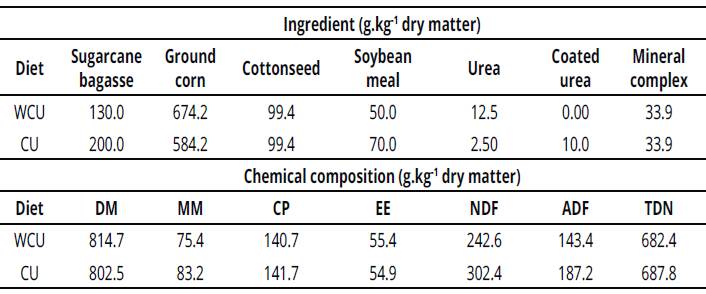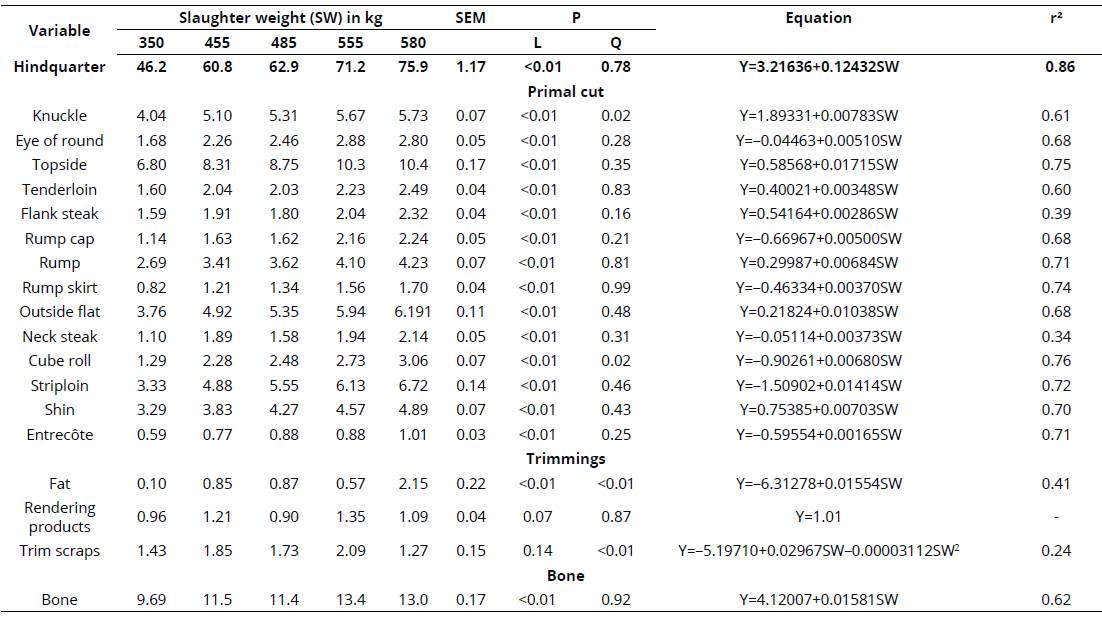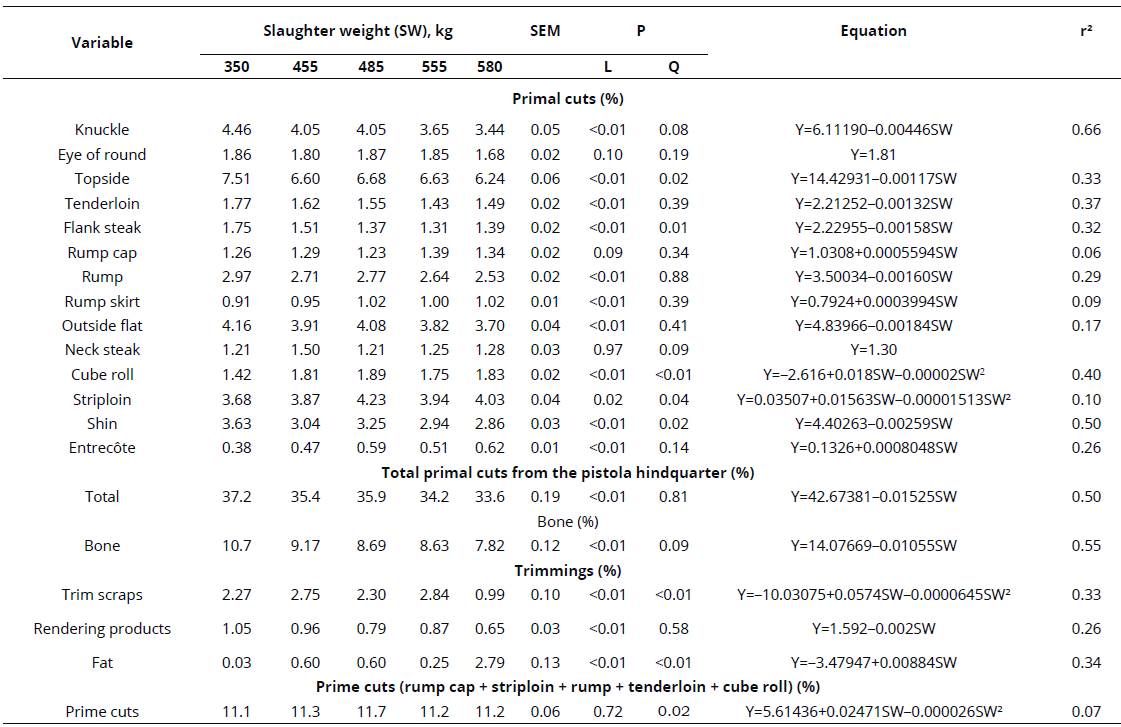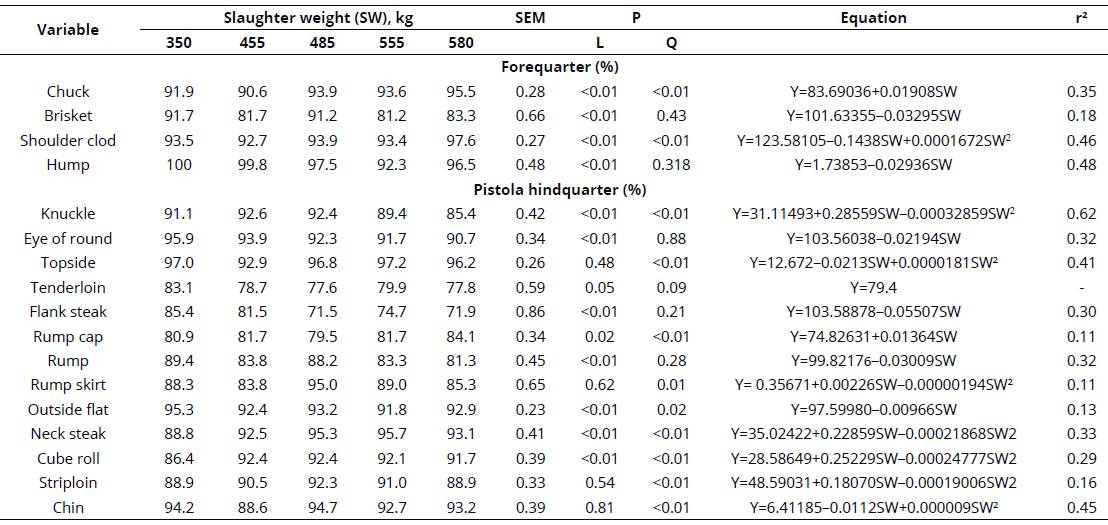Introduction
Brazil is a great beef producer and exporter (Ferraz & Felício, 2010), and most part of its production originates from Bos indicus L. animals, mainly the Nellore breed (Lobato, Freitas, Devincenzi, Cardoso, Tarouco, Vieira... & Castro, 2014). However, beef meat has the challenge to become more competitive in relation to meats from other species like poultry and swine, which have their primal cuts standardized. To achieve this goal, the industry should invest in qualitative aspects, producing high-quality carcasses and meat in an attempt to captivate the Brazilian consumer and broaden its competition in the external market, which has been the ultimate lever for the incentive and growth of this activity (Andrade, Polizel, Roça, Faria, Resende, Siqueira & Pinheiro, 2014). In this regard, primal cuts deserve the attention of slaughterhouses, since both the internal and the external markets require minimum weights of certain muscles that make up these cuts.
Moreover, traits such as weight, conformation, and fatness, in addition to the genotype and wei ght-gain curve, can influence the yield of processed primal cuts. Thus, certain cattle biotypes are more attractive to the industry, though they may incur in higher production costs because of their biological efficiency, which is revealed through a worse feed conversion that generates conflicts with producer interests (Pascoal, Lobato, Restle, Vaz & Vaz, 2009).
Furthermore, the proportion of muscle and fat tissues present in the primal cuts is part of the main criteria considered by the consumer when purchasing a product. However, when the degree of fatness of the carcass is low, the percentage of total scraps is also small, because this tissue is part of the edible portion. In this sense, heavier animals with an adequate degree of fatness tend to produce heavier meat cuts (Pascoal et al, 2010) with a good fat cover for the Brazilian standards (medium to uniform) and consequently, greater uniformity the meat cuts fatness, which is a requirement of import markets besides some Brazilian market niches such as steakhouses and specialty meat shops. However, the processing industry has not yet elucidated the benefits and costs of processing heavier carcasses, since a larger amount of scraps may be generated during the trimming of primal cuts; on the other hand, it may produce high-quality, standardized cuts, with desirable weights and uniformity.
Given the scenario described above, research should be targeted towards the generation of information on the factors influencing the production of the main meat cuts, especially regarding carcass weight and fatness of animals of Zebu origins slaughtered at different weights. Therefore, the aim of this study was to evaluate the influence of slaughter weight on the weights and yields of primal cuts from feedlot-finished young Nellore bulls fed high-concentrate diets containing coated or uncoated urea.
Material and methods
The experiment was conducted in Colina - SP, Brazil (20° 43' 05" S and 48° 32' 38" W), in the experimental facilities of the Regional Center for the Technological Development of Agribusinesses of Alta Mogiana.
In this location, sixty-four young Nellore bulls of 22 months of age were confined in individual, semi-covered stalls each with an area of10 m2 equipped with individual feeders and water troughs.
Treatments consisted of five slaughter weights (350, 455, 485, 555, and 580 kg) and two diets containing urea (coated or uncoated). The coated urea used in this study was that of commercial brand Optigen® (Alltech). Groups slaughtered at 455 and 485 kg included eight animals for the uncoated-urea diet and seven for the coated-urea diet, totaling 15 animals per slaughter weight. The group slaughtered with a weight of 555 kg was comprised of seven animals per diet, totaling 14 animals. The group slaughtered at 580 kg had eight animals for the uncoated-urea diet and six for the coated-urea diet, totaling also 14 animals. Lastly, for the slaughter weight of 350 kg adopted as the control, six animals were used. The animals were weighed after 16 hours fast of li quids and solids.
Diets were formulated using the Maximum Profit Diet (Ração de Lucro Máximo- RLM, version 3.0) formulation software so as to provide the nutrients required for an average daily weight gain of 1.500 kg according to the requirements proposed by the NRC (2000) and can be seen in Table 1.
Table 1 Composition of the diet used in the feeding of the experimental animals

WCU = diet without coated urea; CU = diet with coated urea; DM = dry matter; MM = mineral matter; CP = crude protein; EE = ether extract; NDF = neutral detergent fiber; ADF = acid detergentfiber; TDN = total digestible nutrients.
Animals were slaughtered and carcasses were deboned at the Frigorífico JBS ® slaughterhouse, located in Barretos - SP, Brazil, 20 km away from the experimental feedlot, following the normal slaughterhouse flow. On the slaughter line, carcasses were divided into two equal halves. Afterwards, the half-carcasses were weighed, washed, and stored in a cold room for 24 h at a temperature of 0-4 °C. After this cooling period, carcasses were weighed again, revealing the cold carcass weight. The right half-carcass was subdivided into the following primary cuts: forequarter, between the fifth and sixth ribs; short ribs; and pistola hindquarter.
Subsequently, primary cuts were separated by a trained staff of the slaughterhouse to obtain the primal cuts for the Brazilian market. The forequarter was deboned into the following meat cuts: chuck, brisket, shoulder clod, and hump. The pistola hind-quarter was deboned into rump cap, striploin, cube roll, rump, tenderloin, topside, outside flat, knuckle, eye of round, flank steak, rump skirt, neck steak, entrecôte, shin, and oyster steak.
Moreover, primal cuts were weighed as is (no trimming) and trimmed, and trimmings were divided into trim scraps, fats, and rendering products, in addition to the forequarter tendon. Subsequently, we determined the processing yield of the trimmed cut relative to the untrimmed cut, which was multiplied by 100; and the percentage of trimmed cuts relative to the cold carcass weight and to the weight of the primal (fore- and hind-quarter) cuts multiplied by 100. Short ribs were not deboned into cuts.
In addition, a completely randomized experimental design with a 5 χ 2 factorial arrangement (five slaughter weights and two diets) was adopted. Data were subjected to a normality test by the Shaphiro-Wilk test. The variables trim scraps and rendering products from the forequarter and trim scraps and fat from the pistola hindquarter were analyzed after square-root transformation, while the variable yield of primal cuts and rendering products relative to the pistola hindquarter were analyzed after log transformation, as they did not show normal distribution. The effect of the slaughter weight per diet interaction was initially tested and analyzed separately, because it was not significant for the evaluated variables. Data were subjected to analysis of variance, polynomial contrasts, and regressions (linear and quadratic) using the SAS (2001) statistical software, adopting a = .05. The contrast coefficients were estimated as a function of the slaughter weights.
Results
There was no significant effect of the interaction between slaughter weights and diets for the studied variables. Likewise, no significant effect of coated-urea addition was detected on the weight and yield of primal meat cuts, bones, and trimmings.
Additionally, absolute weights of trimmed primal cuts and trimmings from the forequarter increased linearly as the body weight of animals increased (Table 2). Every one-kilogram increase in body weight resulted in a gain of 50, 19, 33, and 22 g in weights of chuck, brisket, shoulder clod, and hump, respectively.
Regarding forequarter cuts, animals slaughtered at 350 and 580 kg had their chuck, brisket, and shoulder clod weights increased by 10.6, 4.7, and 7.8 kg, which correspond to increases of 86, 121, and 74 %, respectively. Their hump, in turn, increased in weight by 325.3 % due to sexual dimorphism.
Moreover, percentages of brisket and hump increased linearly by 0.0033 and 0.0088 % with every additional kilogram of body weight, respectively, while the shoulder weight decreased by 0.0025 % with every kilogram increase in body weight (Table 3). Chuck weight responded qua-dratically with a point of minimum observed when animals had a body weight of 455.3 kg. Moreover, the sum of all cuts from the forequarter increased linearly relative to the weight of the cold right 1/2 carcass as slaughter weight increased.
Table 2 Weight of primal cuts, scraps, and bone from the forequarter of the right 1/2 carcass ofyoung Nellore bulls slaughtered at different bodyweights

L and Q: linear and quadratic effects; SEM = standard error of the mean; Ρ = probability; Forequarter = weight of the right forequarter
Table 3 Percentages of primal cuts from the forequarter relative to cold right 1/2 carcass weight of young Nellore bulls slaughtered at different bodyweights

L and Q: linear and quadratic effects; SEM = standard error of the mean; Ρ = probability.
Table 4 Weight of trimmed primal cuts and trimmings from the pistola hindquarter of the cold right 1/2 carcass of young Nellore bulls slaughtered at different body weights

L and Q: linear and quadratic effects; SEM = standard error of the mean; Ρ = probability.
In the analysis of trimmings and bones from the forequarter relative to cold right 1/2 carcass weight, we observed that percentages of bone and trim scraps decreased as body weight was increased, while rendering products were not influenced by the animals' slaughter weight.
Likewise, absolute weights of trimmed primal cuts (Table 4) from the pistola hindquarter of the right 1/2 carcass increased linearly with slaughter weight.
Considering prime cuts from the hindquarter, according to the regression equations, for every 1 kg increase in slaughter weight, weights of rump cap, striploin, cube roll, rump, and tenderloin increased by 5.0, 14.1, 6.8, 6.8, and 3.5 g, respectively.
Scraps and bone in the pistola hindquarter showed distinct responses. The percentages of bone and fat rose linearly with the weight of animals, and increase in the latter tissue was caused by the greater deposition of that component in the carcass of the experimental animals, increasing by 219.5% in case of the cattle slaughtered at 580 kg in relation to those weighing 350 kg. By contrast, weights of scraps responded quadratically, whereas rendering products had no interferences from slaughter weight.
As shown in Table 5, for percentage of trim med meat cuts from the pistola hindquarter relative to the weight of the cold right 1/2 carcass, rump cap, rump skirt, and entrecôte increased linearly as body weight of the animals increased. Eye of round and neck steak were not influenced by slaughter weight. Cube roll and striploin showed a quadratic response. The sum of prime cuts (rump cap, striploin, cube roll, rump, and tenderloin) relative to the weight of the cold right 1/2 carcass had a quadratic response, with the highest percentage obtained when animals had a body weight of 475.2 kg.
Likewise, processing yields of primal cuts (Table 6), i.e. rump cap and rump, increased as the slaughter weight and fatness of the bulls increased.
Table 5 Percentage of cuts from the pistola hindquarter relative to the weight of the cold right 1/2 carcass of young Nellore bulls slaughtered at different body weights

L and Q: linear and quadratic effects; SEM = standard error of the mean; Ρ = probability.
Discussion
As seen in the results, there was no significant effect of the interaction between diets and slaughter weights for the studied variables. Likewise, no significant effect of coated-urea addition was detected on the weight and yield of primal meat cuts, bones, and trimmings. These results may be attributed to similar slaughter weights (518.0 kg), carcass weight (278.1 kg), fat thickness (4.47 mm), and physical composition of animal carcasses (muscle 58.2 %, fat 25.8 % and bone 15.8 %) (Pazdiora, Resende, Faria, Siqueira, Almeida, Sampaio. & Prietto, 2013).
Furthermore, absolute weights of trimmed primal cuts and trimmings from the forequarter increased linearly as the body weight of animals increased. These results may be attributed to the increase in carcass weight, which stemmed mainly from deposition of muscle mass and fat.
Percentages of brisket and hump increased linearly with every additional kilogram of body weight, while the shoulder weight decreased with every kilogram increase in body weight. Authors as Pazdiora et al. (2013) for example found greater representativeness of the forequarter as the slaughter weight of the animals increased, which might have been a result of the sexual dimorphism of uncastrated animals, where a more accelerated muscle development of the forequarter is observed in comparison with the pistola hindquarter. However, Pascoal et al. (2010) found no differences for percentage of forequarter cuts relative to carcass weight in Braford cattle slaughtered with a carcass weight of 184, 205, and 229 kg. Moreover, those authors found mean values of 2.68 % and 4.32% for brisket and rump, respectively, which are much lower figures than those found in the present study.
In the analysis of trimmings and bones from the forequarter relative to cold right 1/2 carcass weight, we observed that percentages of bone and trim scraps decreased as body weight was increased, while rendering products were not influenced by the animals' slaughter weight. Ledic, Tonhati & Fernandes (2000), did not find differences in percentage of bone, which averaged 8.02 %. Pascoal et al. (2010) found no differences in Braford animals slaughtered at 184, 205, and 229 kg of carcass for edible and discarded trimmings, which accounted for an average 1.30 and 2.45 % of the carcass, respectively.
Likewise, absolute weights of trimmed primal cuts from the pistola hindquarter of the right 1/2 carcass increased linearly with slaughter weight, as a consequence of the greater muscle growth and deposition of adipose tissue in the carcass, as observed in the work of Pazdiora et al. (2013). These results are similar to those found by Pascoal et al. (2010), who attributed them to a better conformation and to an increase in carcass weight and fat deposition.
Considering prime cuts from the hindquarter, according to the regression equations, for every 1 kg of increase in slaughter weight, weights of rump cap, striploin, cube roll, rump, and tenderloin increased each a certain amount. These represent the cuts of greatest financial return. According to Pascoal et al. (2010), the absolute weight of the primal cuts from the hindquarter increases together with slaughter weight, and this may be advantageous if processing cost is considered per slaughtered animal unit. Heavier cuts with greater deposition of fat usually have distinguished sale prices. Some of these cuts, e.g. chuck, striploin, and rump cap, increase in value as the weight and fatness of the carcass increase, which is achieved through an elevation in slaughter weight, as can be seen in Table 4.
Scraps and bone in the pistola hindquarter showed distinct responses. The percentages of bone and fat rose linearly with the weight of animals, and increase in the latter tissue was caused by a greater deposition of that component in the carcass of the experimental animals. In contrast, scrap weight responded quadratically, whereas rendering products had no interferences from slaughter weight. Bonilha, Tedeschi, Packer, Razook, Alleoni, Nardon & Resende (2008), evaluated different genetic groups and found a larger amount of trimmings in animals that had a larger amount of fat in the carcass. Considering animals slaughtered at 580 kg in comparison with those sacrificed at 555 kg, a considerable increase was observed in the quantities of fat generated as trimmings from the meat cuts, although the material generated as scraps and rendering products was lighter in weight.
Regarding percentage of trimmed meat cuts from the pistola hindquarter relative to cold right 1/2 carcass, rump cap, rump skirt, and entrecote weight increased linearly as body weight of the animals increased. Moreover, eye of round and neck steak were not influenced by slaughter weight. Cube roll and striploin showed a quadratic response. These findings suggest that, in slaughtering heavier animals, the slaughterhouse produces meat cuts proportionally with more added value, mainly rump cap and striploin, possibly because of the greater deposition of fat in these cuts.
The sum of prime cuts (rump cap, striploin, cube roll, rump, and tenderloin) relative to the weight of the cold right 1/2 carcass had a quadratic response, however, these cuts may account for more than 30% of the carcass sale price.
Knuckle, topside, tenderloin, flank steak, rump, topside, and shin had their percentages decreased as body weight increased, and this response contributed to the linear reduction of the sum of all trimmed cuts from the pistola hindquarter relative to the weight of the cold right 1/2 carcass, likely due to the decreasing representativeness of the pistola hindquarter as slaughter weight of the animal increases (Pazdiora et al., 2013). This might have been due to sexual dimorphism of uncastrated animals, as mentioned previously. This decrease is not of interest to the slaughterhouse, since the cuts most valued by the market are found in the hindquarter; however, the slaughter of heavier animals may be advantageous in that it dilutes the operating cost of the slaughterhouse.
The analysis of trimmings and bones from the pistola hindquarter relative to the weight of the cold right 1/2 carcass revealed that percentages of bone and rendering products decreased as body weight was increased, and fat trimmings increased linearly due to the accumulation of fat deposited in the carcass; this was however, verified by the greater subcutaneous fat thickness in the carcass of the experimental animals (Pazdiora et al., 2013). Furthermore, this is a consequence of the growth curve as a function of the weight and age of the animals, wherein the bone tissue has a greater growth impulse at younger ages, while the adipose tissue has its growth occurring at more-advanced ages and muscle growth at intermediate ages (Berg, Aandersen & Liboriussen, 1978; Müller & Primo, 1986).
Likewise, processing yields of primal cuts increased as the slaughter weight and fatness of the bulls increased, likely because they produced cuts with greater uniformity of fat, consequently less susceptible to the trimming process. In addition to this benefit, a number of operational advantages in the slaughterhouse should be considered, since the slaughter of heavier animals involves costs similar to that of the slaughter of lighter animals in several aspects, e.g. labor, storage, and transport, besides generation of cuts of higher added value for both the internal and the exports markets. The rump cap did not present the same quantity of trimmings as other cuts, which traditionally have good amounts of fat. It was clear, during the trimming process, that the rump caps from the heavier animals, slaughtered with a higher degree of fatness, had greater uniformity and generated less trimming product.
Moreover, processing yield of primal cuts eye of round, flank steak, outside flat, rump, brisket, and hump decreased as slaughter weight increased, generating a larger amount of trimmings. Furthermore, processing yields of knuckle, topside, rump skirt, neck steak, cube roll, striploin, shin, and shoulder clod had a quadratic response. For the tenderloin, the processing yield was not influenced by the slaughter weight, since this cut is typically devoid of intermuscular fat or a fat cover.
Conclusions
Heavier meat cuts are obtained as the slaughter weight is increased, adding value to the industry.
Percentage of total cuts from the pistola hindquarter relative to the carcass weight decreases as the slaughter weight of young Nellore bulls increases. Higher slaughter weights provide higher percentages of fat in the trimmings, thereby reducing the yields of cuts, especially those from the hindquarter.
The use of coated urea does not increase the yields of meat cuts from Nellore cattle slaughtered in the body-weight range of 455 to 580 kg.















